Almonds and acquiring knowledge
- rosemarydearman1
- Jul 5, 2019
- 8 min read
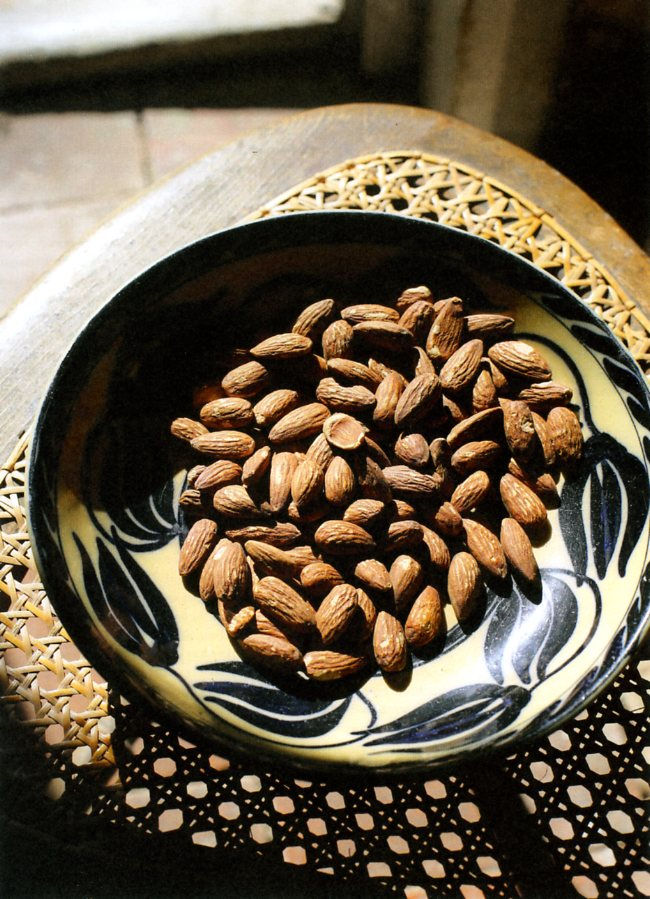
"Did you know that an almond is actually a peach in disguise?" Maggie Beer
It's David's special meal day and he designated almonds as the theme. Well he had been making his own roasted and vinegar flavoured almonds - ugh is all I can say to that, but each to his own I guess.
So I began looking for a suitable recipe, and as I searched my cookbooks I thought to myself what a long way I had come in knowledge about food since my youth, as I decided which books were most likely to yield an interesting result. For I chose Greg Malouf, Yotam Ottolenghi, Claudia Roden, Robert Carrier to begin with. Robert Carrier for his Moroccan period, Claudia Roden for her Spanish book in particular and the others for their Middle Eastern origins. I had learnt that almonds were most often used in those cuisines. I had journeyed a long way from the marzipan of my youth and knowing nothing about where the almonds I sometimes saw in packets in the grocer's came from. But I also learnt a few new, and sometimes surprising things along the way.
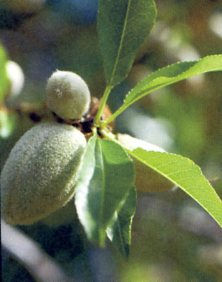
So what did I learn that was new along the way? First of all - green almonds. Very hard to find unless you have an almond tree - possibly in a farmer's market, but I doubt you will find them anywhere else.
When I was a young teenager, as I have said many times before, I spent my summers in France staying with two different French girls. Simone lived in a small village near Orléans, on the Loire, called Meung-sur-Loire. Her father was the town clerk and they lived in the beautiful old town hall, behind which was a small park, in which grew, amongst many other things, some almond trees. I remember she used to eat the young green almonds from the tree. In my ignorance I thought they would be unripe and therefore probably yucky and horrible, besides they were furry too, so I think I refused tasting them. I don't remember tasting them anyway. But she loved them. And it seems there is a reason for this. They are a delicacy to many, and not available to buy usually.
"The whole almond has a crisp, watery texture and a tart flavor, like a cross between a green apple and a green grape." Emma Christensen - Kitchn
"When the outer layer is removed, the young almonds are delicate, milky, and subtly floral and grassy." Kristy Mucci - Saveur

You can use them in all sorts of ways, though most people seem to just eat them, or salt them and use them as a snack. The most interesting recipe I found was
Olive-oil poached green almonds with dill which Kristy Mucci from Saveur had found in a restaurant called Lokanta May in Istanbul.
But it's a curiosity really and not something either you or I are ever going to come across unless we grow almonds in our garden.
The next thing I learnt was that almonds were and indeed still are, poisonous. Well bitter almonds are poisonous, and once all almonds were the bitter type. Nowadays these are used in marzipan, almond essence and almond liqueurs. They have not much to do with the sweet almonds that we all know and love.
"Many of our most popular foodstuffs are inedible and even poisonous in their wild state. And yet, as long ago as 300BC, in an extraordinary feat of primitive genetic engineering, our ancestors in the eastern Mediterranean learned how to select sweet, non-poisonous almonds from the bitter majority, and began the cultivation of one of the world's most important nuts." Lucy Malouf - Arabesque
There is so much to absorb there. So long ago. And why would anybody have thought to try and develop sweet almonds? How many people died in the experiment? We really don't credit our ancient ancestors with the brainpower that they must have had to develop agriculture - because that is basically what they did. And developing agriculture must have involved genetic experimentation - even though they did not know that that was what they were doing. The poison is a chemical that becomes cyanide, and that's where the relationship is to the peach and the apricot, maybe plums too. They are all varieties of prunus and I know that the kernel of the seed in the centre of apricots does indeed contain cyanide - or prussic acid. With almonds if you eat as many as fifty of the bitter almonds then you will most probably die. Mind you, as Maggie Beer says, the taste is so bitter that nobody is likely to eat more than two or three. There must have been enough sweet almonds on those first almond trees for our ancestors to consider breeding them into new trees.

And whilst we are still on botany:
"Botanically speaking, almonds aren’t nuts. They’re actually stone fruits, and the almonds we all snack on are the seeds within the stones of the fuzzy green fruit" Kristy Mucci - Saveur
Peaches and almonds again.
Still in general research mode I also learnt that:
"When the Arabs conquered Persia in the seventh century, the almond was just one of many new foods they discovered. ... As they expanded their empire westwards, the Arabs took with them many newly discovered foods, such as the almond tree, to cultivate in their new colonies and to trade with customers in Europe." Lucy Malouf
I suppose I sort of knew all this, and I certainly knew about the new foods that came from the Americas and caused a renaissance in cooking in the 15th and 16th centuries. I don't think though, that I was really aware that the Arabs had conquered the Persians. It's one of those things that one sort of knows subliminally but not in detail. Or hadn't really thought about. And certainly not with respect to the impact on food. I knew the Arabs had conquered parts of Europe - particularly Spain and Sicily, and that this had influenced their food, but not that the Persians had influenced the Arabs. Which made me think more about how colonisations, both actual and economic, influence the ways we eat. Let alone the actual food we eat.
I am not going to go into the health benefits and commercialisation of almonds here. Maybe another time. Suffice to say that the almond market worldwide is huge. It is so versatile a product, being not just food but a component in so many beauty and health products too. Most of them come from California apparently, but I think Australia grows a lot too. I thought of investing in them once.
Before I go on to what I actually finally chose to cook David, here are two or three 'little' things to do with almonds.
1. ALMOND BUTTER (like peanut butter, only almonds. From Maggie Beer)
Roast almonds on a tray in an oven at 220ºC for a few minutes or until they pop their skins just a little.
Pulse in a food processor. Add a drop of cold water or rosewater after two or three pulses, so the oil in the almond doesn't split, then add room temperature unsalted butter in the same proportion as the nuts. Pulse again until the nuts and butter are incorporated, then roll into a log and wrap in baking paper (it will oxidise if not totally covered) and refrigerate for a few days. Spread wholemeal toast with almond butter for breakfast, or smother whole trout with it before cooking, adding a squeeze of lemon juice and freshly ground pepper."
2. "spaghettini with flaked almonds, extra virgin olive oil, flat-leaf parsley and lots of freshly ground black pepper is a meal in a moment; a nutty ripe avocado can be sliced in this dish too." Maggie Beer
3. ROASTED ALMOND AIOLI From the River Cottage people (click on the title to find the recipe.
4. TOASTED SALTED ALMONDS
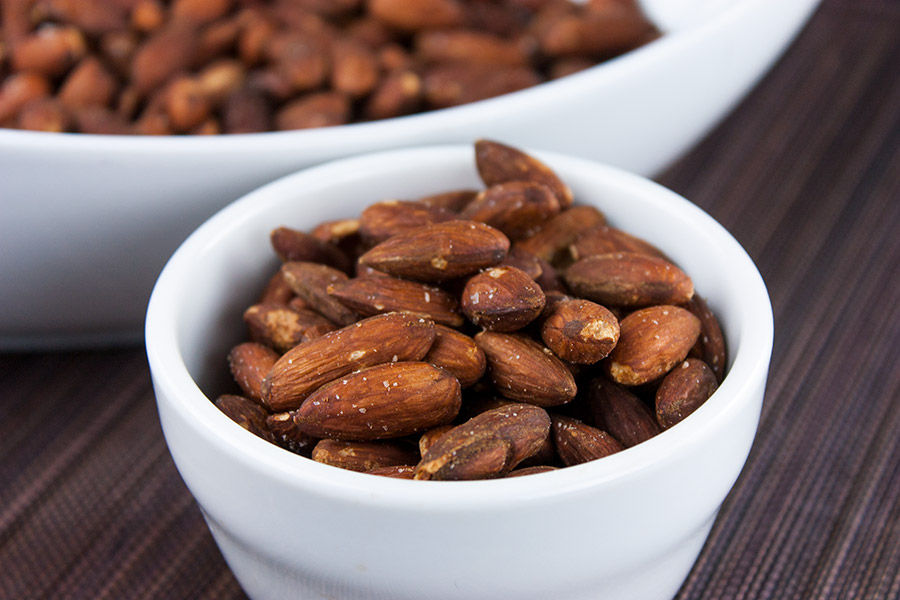
"Nothing yet invented so sets the gastric juices to work as the sight of a plateful of freshly toasted and salted almonds. Even to say the words or to see them written does the trick. ... Left where anybody can see them, a pound of salted almonds will be devoured within fifteen minutes."
Elizabeth David
Her recipe uses half a pound of blanched almonds, although all the pictures I could find were of almonds still with their skins on. The almonds are mixed with a teaspoonful of almond oil or butter then put in a baking tin, greased with the oil or butter. Roast for about 45 mins in a slow oven (150ºC) until a pale toast colour. Tip them on to a sheet of greaseproof paper covered with three tablespoons of sea salt flakes. Swish them around and make a little parcel of them for storing. When you are ready to serve, shake off excess salt, sprinkle with a tiny bit of cayenne and serve.
So back to David. This time I actually gave him three choices and in the end two of them were actually from Jamie Oliver. I found these, having exhausted my own library's resources - well not really - but those I chose to explore - by visiting my favourite cooks' websites and feeding in almonds. These were the choices - all worth doing I have to say.
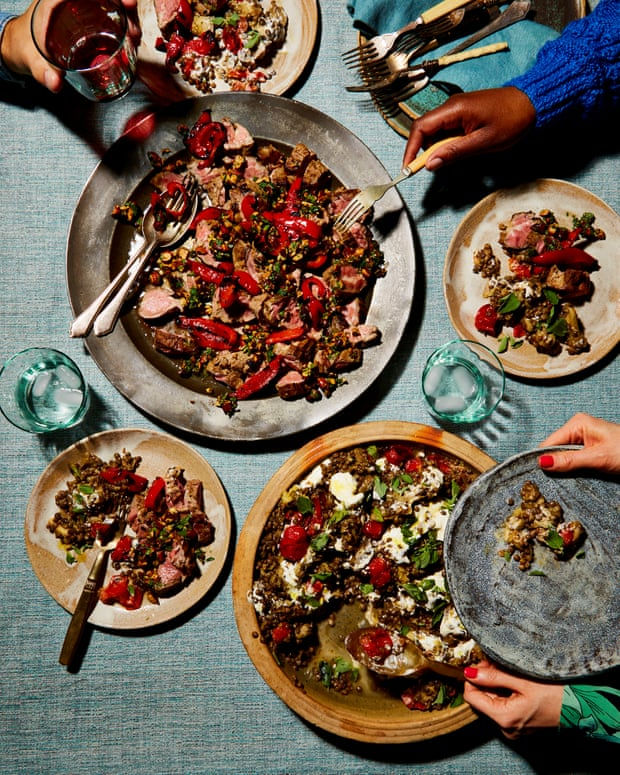
From Yotam Ottolenghi this one. And boy did it sound delicious. I had the red peppers required too. But I didn't have the lamb and we had lamb the other day, so this was declined. Another time perhaps because it sounded really good, if a bit expensive - lamb fillet. It came from his Simple book.
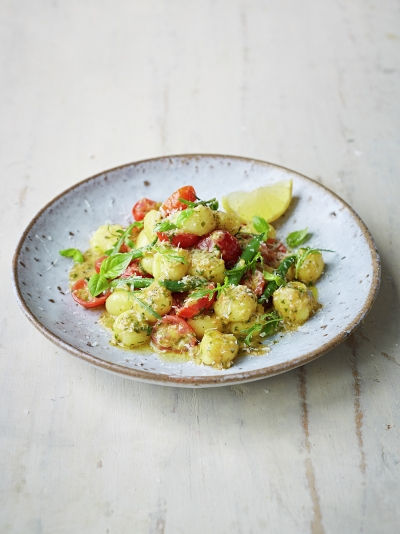
2. Gnocchi alla Trapanese from Jamie Oliver's website. Actually I first found this recipe on a fan website, where it was actually a recipe for spaghetti and I did find this version in his Italy cookbook. However, this is the picture that I showed David. The sauce is the same as in the other two recipes. This was also very tempting and as I was looking for a picture I found that it is a traditional dish - one of those Arab influenced Sicilian dishes, so I might give it a post all of its own sometime. My brief look at other people's versions rapidly showed me that it's another one of those 'what's authentic?' dishes.
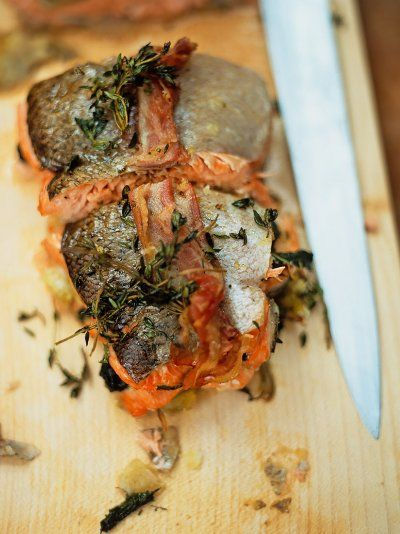
In the end David chose Roasted trout and artichokes with almonds, breadcrumbs and mint. I don't have the book it comes from - Jamie's Kitchen, but it's there on his website. David said he chose it because he had thought of Truite aux Amandes, which is, of course another famous almond dish, but I think we had this as a special meal some time ago. Besides I did not have any whole trout, but I did have some trout fillets. Courtesy of a special at Coles. We had to go and get the artichokes and the thyme though - my thyme has more or less finished for the year. Anyway that was an excuse for me to walk back from the shops and get my exercise for the day.
With plain boiled potatoes I think - the little ones I bought in the market the other day, and a plain green salad. And a glass of ordinary Lindeman's sauvignon blanc. Not wonderful wine but very drinkable.
So a healthy, and I hope delicious meal that I should probably go and start preparing.
You can, of course, do lots and lots of sweet things with almonds, but that's a whole other post.












Comments